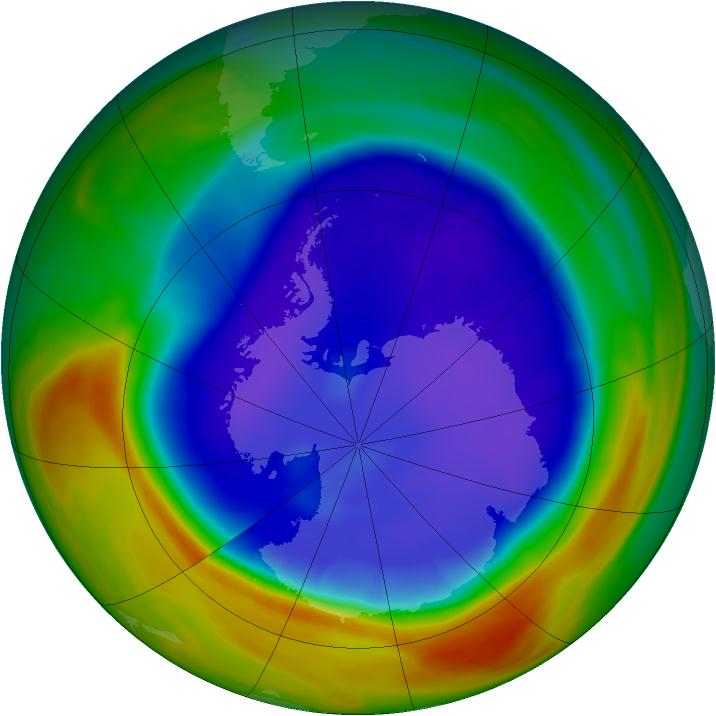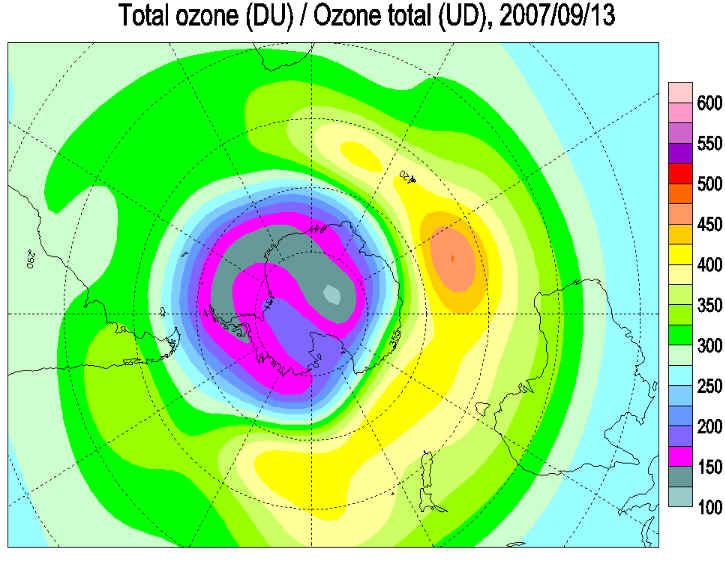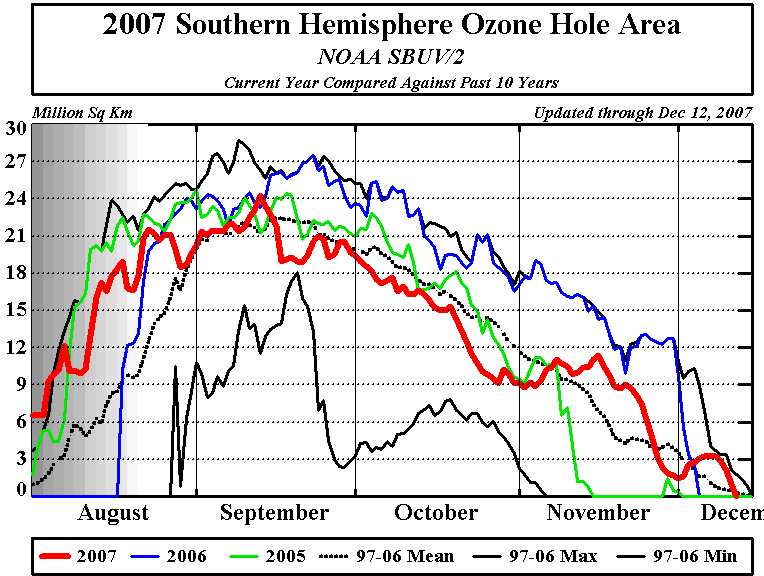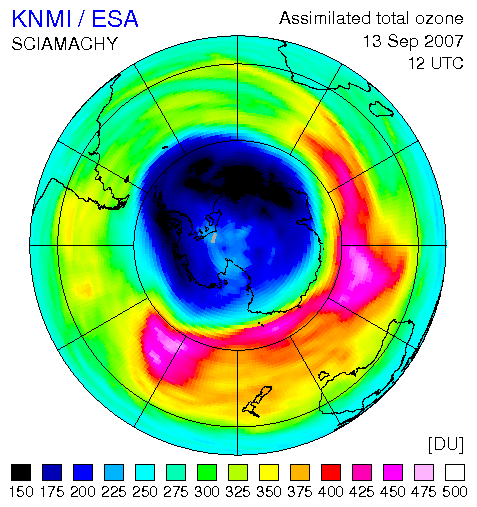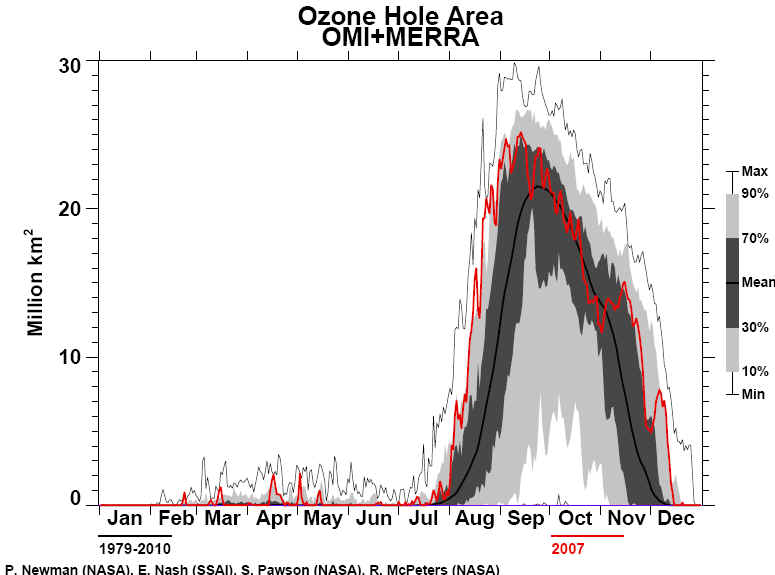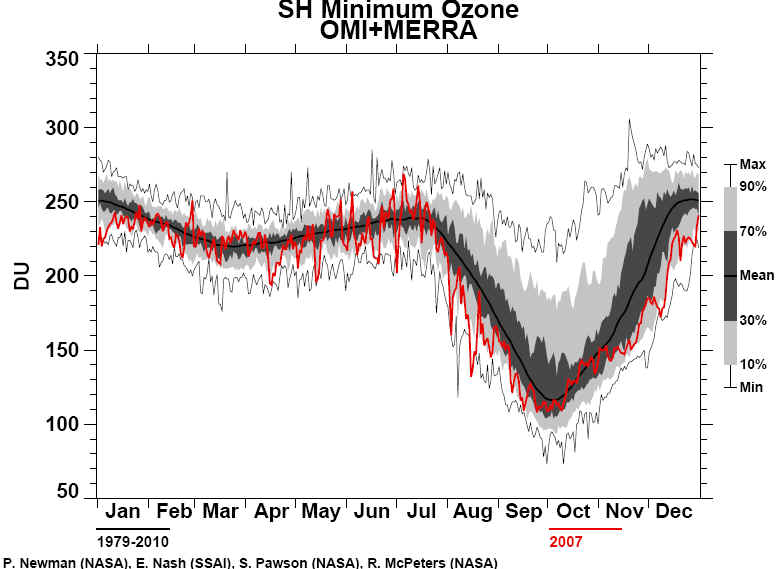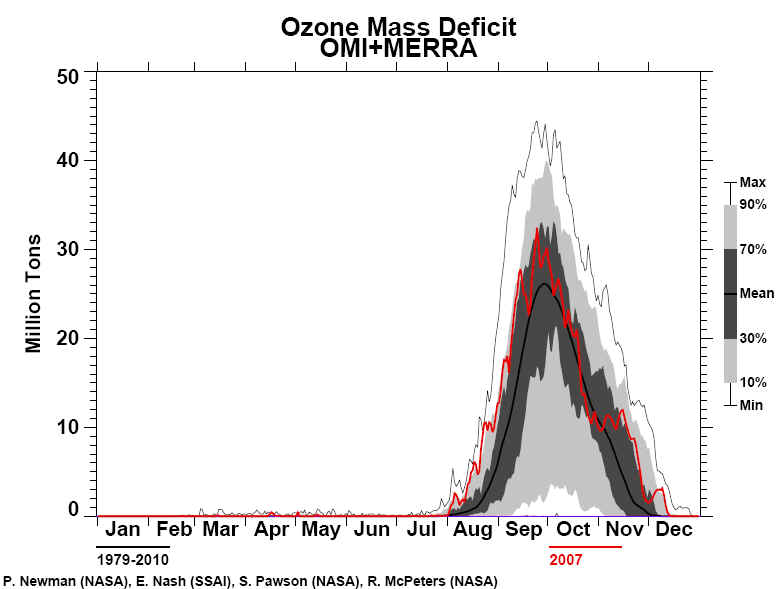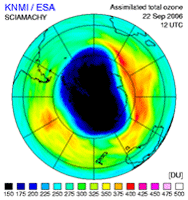|
Ozone Hole 2007
http://ozonewatch.gsfc.nasa.gov
http://www.cpc.ncep.noaa.gov/products/stratosphere/sbuv2to/ozone_hole.sht
NASA Data Reveals 'Average' Ozone Hole in 2007
18 October 2007-NASA-Data from NASA's Earth-observing Aura satellite show that the ozone hole peaked in size on Sept. 13,2007 reaching a maximum area extent of 9.7 million square miles(24.7Area (million sq. km)) just larger than the size of North America. That's "pretty average," says Paul Newman, an atmospheric scientist at NASA Goddard Space Fight Center, when compared to the area of ozone holes measured over the last 15 years. Still, the extent this year was "very big," he says, compared to 1970s when the hole did not yet exist.
2007 ozone hole ‘smaller than usual’
3 October 2007 ESA-The ozone hole over Antarctica has shrunk 30 percent as compared to last year's record size. According to measurements made by ESA’s Envisat satellite, this year’s ozone loss peaked at 27.7 million tonnes, compared to the 2006 record ozone loss of 40 million tonnes. Ozone loss is derived by measuring the area and the depth of the ozone hole. The area of this year’s ozone hole – where the ozone measures less than 220 Dobson Units – is 24.7 million sq km, roughly the size of North America, and the minimum value of the ozone layer is around 120 Dobson Units. A Dobson Unit is a unit of measurement that describes the thickness of the ozone layer in a column directly above the location being measured. For instance, if an ozone column of 300 Dobson Units is compressed to 0º C and 1 atmosphere (the pressure at the Earth’s surface) and spread out evenly over the area, it would form a slab of ozone approximately 3mm thick.
Scientists say this year’s smaller hole – a thinning in the ozone layer over the South Pole – is due to natural variations in temperature and atmospheric dynamics (illustrated in the time series to the right) and is not indicative of a long-term trend. "Although the hole is somewhat smaller than usual, we cannot conclude from this that the ozone layer is recovering already,” Ronald van der A, a senior project scientist at Royal Dutch Meteorological Institute (KNMI), said. "This year's ozone hole was less centred on the South Pole as in other years, which allowed it to mix with warmer air, reducing the growth of the hole because ozone is depleted at temperatures less than -78 degrees Celsius."
Southern Hemisphere Winter 2007 Summary NOAA Climate Prediction Center-Extensive ozone depletion was again observed over Antarctica during the Southern Hemisphere winter of 2007, with widespread total ozone anomalies of 45 percent or more below the 1979 to 1986 base period. The area covered by extremely low total ozone values of less than 220 Dobson Units, defined as the Antarctic “Ozone Hole” area, in September reached maximum size of greater than 24 million square kilometers, the 7th largest over all 29 years of continuous satellite monitoring of Antarctic ozone. However, after reaching its maximum size, the Ozone Hole diminished in size such that it was just the 17th largest for the month of October. Vertical profiles of ozone amounts, measured by balloon-sondes over the South Pole, showed near-complete destruction of ozone in the 13 to 21 km region for a relatively short period of time due to the Ozone Hole’s displacement off of the pole towards the Atlantic quadrant. Minimum total ozone values observed at the South Pole were higher than those seen during recent years. Lower stratospheric temperatures over the Antarctic region in the winter of 2007 were again well below -78ºC, and were sufficiently low for polar stratospheric cloud formation, promoting chemical ozone loss. The size of the area of very low temperatures in 2007 was, however, average or below average for the past ten years. The polar vortex persisted until mid-December when it and the remains of the Ozone Hole slowly diminished as the polar circulation changed over into its summer pattern. Very low ozone values were again observed over Antarctica in the Winter of 2007. Ozone depletion greater than 45% was observed over Antarctica, compared to total ozone amounts observed in the early 1980's. Vertical soundings over the South Pole during September and October 2007 showed near-complete destruction of ozone at altitudes between 13 and 21 km. Lower stratosphere temperatures in the winter of 2007 over the Antarctic region were near average levels. Associated with this, the peak size of the Ozone Hole was smaller than the record breaking sizes seen this past decade. Other characteristics of the 2007 Ozone Hole are that it was near the 10-year average or below it for a major fraction of its existence, it was off center from the South Pole for most of September and October, but due to the persistence of the polar vortex once it re-centered over the South Pole, the Ozone Hole itself persisted well into December. Observations of chlorofluorocarbons and of stratospheric hydrogen chloride support the view that international actions are reducing the use and release of ozone depleting substances (WMO, 1999; Anderson et al., 2000). However, chemicals already in the atmosphere are expected to continue to impact the ozone amount for many decades to come. The Antarctic Ozone Hole is expected to continue for decades. Antarctic ozone abundances are projected to return to pre-1980 levels around 2060-2075, roughly 10-25 years later than estimated in the 2002 Assessment. The projection of this later return is primarily due to a better representation of the time evolution of ozone-depleting gases in the Polar Regions. In the next two decades, the Antarctic Ozone Hole is not expected to improve significantly (WMO, 2006). Further, changing conditions (i.e. meteorological, solar, and volcanic aerosols) that modulate ozone can complicate the task of detecting the start of ozone layer recovery. The eruption of the Pinatubo volcano provided an example of such a complication in the 1990s. Based on an analysis of 10 years of South Pole ozone vertical profile measurements, Hofmann et al., (1997) estimated that recovery in the Antarctic Ozone Hole may be detected as early as the coming decade. Indicators include: 1) an end to springtime ozone depletion at 22-24 km, 2) 12-20 km mid-September column ozone loss rate of less than 3 DU per day, and 3) a 12-20 km ozone column of more than 70 DU on September 15. An intriguing aspect of recent observations of the Antarctic stratosphere had been the apparent trend towards a later breakup of the vortex in years since 1990, relative to the 1980s. The size and duration and size of the 2007 Ozone Hole is attributed in part to meteorological conditions. A full explanation of such meteorological anomalies is not yet available. Continued monitoring and measurements, including total ozone and its vertical profile, are essential to achieving the understanding needed to identify ozone recovery. Situation at 2007 December 28 British Antarctic Survey Ozone Bulletin The ozone hole of 2007 is over. The temperature of the ozone layer is now highest over Antarctica and cools northwards. It is too warm for polar stratospheric clouds (PSCs) to exist. Generally across Antarctica, ozone values are around 300 DU. Values are now slowly dropping towards the normal autumn normal minimum. In general the circum-polar stratospheric vortex was more disturbed this year than it was last year, however there were also periods of stability. Some areas of Antarctica saw ozone values down to ozone hole levels (less than 220 DU) in mid June, suggesting the possibility of early chemical depletion, combined with some dynamic processes. In mid July the minimum temperature of the Antarctic stratosphere at 70 & 50 hPa was close to the normal, although that at 30 hPa was below the normal, and I suggested the likelihood of another strong ozone hole year. Early August saw the largest ozone hole recorded for this time of year, although at the same time very high ozone levels existed over the northern Antarctic Peninsula. The vortex was more circular in mid September but returned to an elliptical shape and initially warmed slowly. In mid September the ozone hole area reached a maximum of just over 24 million square kilometres, but it then slowly shrank as the vortex warmed further. A spring warming took place over the Pacific coast of Antarctica and the Antarctic Peninsula in late October, however this subsided as the ozone hole became more symmetric again. A second major warming took place towards the end of November, but subsided in early December. Around December 8 the ozone hole was briefly the largest on record for the date. The tip of South America and the Falkland Islands saw ozone levels below 250 DU on August 24, with South Georgia experiencing similar levels on September 4. The fringes of the ozone hole were over South Georgia on September 11. The area was intermittently affected from September 22 to October 22, with South Georgia particularly affected on September 25, when values dropped below 175 DU. The Falklands and South Georgia were affected for a final time between November 23 and 25. Situation at 2007 December 17 British Antarctic Survey Ozone Bulletin The ozone hole of 2007 is essentially over, although a small weakening polar vortex remains over East Antarctica. The temperature of the ozone layer within the vortex is now too warm for PSCs. Ozone values here are still low, with ozone values below 250 DU and depletions approaching 30%. Elsewhere over Antarctica ozone values are higher, up to 350 DU in places. A spring warming took place over the Pacific coast of Antarctica and the Antarctic Peninsula in late October, however this subsided as the ozone hole became more symmetric again. A second major warming took place towards the end of November, but subsided in early December. The summer circulation is likely to be established by the December solstice. In general the vortex has been more disturbed this year than it was last year, however there have also been periods of stability. Early August saw the largest ozone hole recorded for this time of year, although at the same time very high ozone levels existed over the northern Antarctic Peninsula. The vortex was more circular in mid September but returned to an elliptical shape and initially warmed slowly. In mid September the ozone hole area reached a maximum of just over 24 million square kilometres, but it then slowly shrank as the vortex warmed further. Around December 8 the ozone hole was briefly the largest on record for the date. The vortex is expected to continue to decline over the next week, but is likely to remain over East Antarctica until the December solstice. The tip of South America and the Falkland Islands saw ozone levels below 250 DU on August 24, with South Georgia experiencing similar levels on September 4. The fringes of the ozone hole were over South Georgia on September 11. The area was intermittently affected from September 22 to October 22, with South Georgia particularly affected on September 25, when values dropped below 175 DU. The Falklands and South Georgia were affected for a final time between November 23 and 25. Some areas of Antarctica saw ozone values down to ozone hole levels (less than 220 DU) in mid June, suggesting the possibility of early chemical depletion, combined with some dynamic processes. In mid July 2007 the minimum temperature of the Antarctic stratosphere at 70 & 50 hPa was close to the normal, although that at 30 hPa was below the normal, suggesting the likelihood of another strong ozone hole year. This prediction has generally held up, with the ozone hole the largest it has been in early August, and 50% depletion over some areas of Antarctica. Situation at 2007 November 30 British Antarctic Survey Ozone Bulletin The slowly shrinking polar vortex remains in place, with higher ozone values, approaching 400 DU in places, outside the vortex. The temperature of the ozone layer within the vortex remains sufficiently cold that a few stratospheric clouds still exist and some chemical depletion of ozone continues, although temperatures have risen above the PSC formation threshold. A spring warming took place over the Pacific coast of Antarctica and the Antarctic Peninsula in late October, however this subsided as the ozone hole became more symmetric again, a second major warming took place towards the end of November. Inside the vortex, ozone values are still below 220 DU, with lowest ozone values are around 200 DU over East Antarctica. In general the vortex has been more disturbed this year than it was last year, however there have also been periods of stability. Early August saw the largest ozone hole recorded for this time of year, although at the same time very high ozone levels existed over the northern Antarctic Peninsula. The vortex was more circular in mid September but returned to an elliptical shape and initially warmed slowly. In mid September its area reached a maximum of just over 24 million square kilometres, but has now declined to 3 million square kilometres, close to the average for the last decade at this time of year. The vortex is expected to continue to decline over the next week. The tip of South America and the Falkland Islands saw ozone levels below 250 DU on August 24, with South Georgia experiencing similar levels on September 4. The fringes of the ozone hole were over South Georgia on September 11. The area was intermittently affected from September 22 onwards, with South Georgia particularly affected on September 25, when values dropped below 175 DU. Some areas of Antarctica saw ozone values down to ozone hole levels (less than 220 DU) in mid June, suggesting the possibility of early chemical depletion, combined with some dynamic processes. In mid July 2007 the minimum temperature of the Antarctic stratosphere at 70 & 50 hPa was close to the normal, although that at 30 hPa was below the normal, suggesting the likelihood of another strong ozone hole year. This prediction has generally held up, with the ozone hole the largest it has been in early August, and 50% depletion over some areas of Antarctica. Situation at 2007 November 9 British Antarctic Survey Ozone Bulletin The shrinking polar vortex remains in place, with higher ozone values, approaching 400 DU in places, outside the vortex. The temperature of the ozone layer within the vortex remains sufficiently cold that some stratospheric clouds still exist and chemical depletion of ozone continues, although temperatures have risen above the PSC threshold. Over the Pacific coast of Antarctica and the Antarctic Peninsula a spring warming has taken place, with ozone layer temperatures too high for stratospheric clouds. Inside the vortex, ozone values are below 220 DU, with the ozone hole covering about half the continent. Lowest ozone values are around 150 DU near the centre of Antarctica. In general the vortex has been more disturbed this year than it was last year. Early August saw the largest ozone hole recorded for this time of year, although at the same time very high ozone levels existed over the northern Antarctic Peninsula. The vortex was more circular in mid September but returned to an elliptical shape and initially warmed slowly. In mid September its area reached a maximum of just over 24 million square kilometres, but has since declined to 10 million square kilometres, close to the average for the last decade at this time of year. Some areas of Antarctica saw ozone values down to ozone hole levels (less than 220 DU) in mid June, suggesting the possibility of early chemical depletion, combined with some dynamic processes. The tip of South America and the Falkland Islands saw ozone levels below 250 DU on August 24, with South Georgia experiencing similar levels on September 4. The fringes of the ozone hole were over South Georgia on September 11. The area was intermittently affected from September 22 onwards, with South Georgia particularly affected on September 25, when values dropped below 175 DU. In mid July 2007 the minimum temperature of the Antarctic stratosphere at 70 & 50 hPa was close to the normal, although that at 30 hPa was below the normal, suggesting the likelihood of another strong ozone hole year. In late August this prediction seemed to be holding, with the ozone hole the largest it had been in early August, and 50% depletion over some areas of Antarctica. Currently it is about average in size compared to the last decade. Situation at 2007 October 15 British Antarctic Survey Ozone Bulletin The winter polar vortex remains in place, with higher ozone values, exceeding 400 DU in places, outside the vortex. The temperature of the ozone layer within the vortex remains sufficiently cold that stratospheric clouds continue to exist and chemical depletion of ozone continues. Here, ozone values are below 220 DU, with the ozone hole covering much of the continent, but offset towards the Atlantic. Lowest ozone values are below 130 DU over Halley. In general the vortex is more disturbed this year than it was last year. Early August saw the largest ozone hole recorded for this time of year, although at the same time very high ozone levels existed over the northern Antarctic Peninsula. The vortex was more circular in mid September but has returned to an elliptical shape and is warming slowly. In mid September its area was 24 million square kilometres, but has since declined to 16 million square kilometres, only a little smaller than the average for the last decade at this time of year. Some areas of Antarctica saw ozone values down to ozone hole levels (less than 220 DU) in mid June, suggesting the possibility of early chemical depletion, combined with some dynamic processes. The tip of South America and the Falkland Islands saw ozone levels below 250 DU on August 24, with South Georgia experiencing similar levels on September 4. The fringes of the ozone hole were over South Georgia on September 11. The area was intermittently affected from September 22 onwards, with South Georgia particularly affected on September 25, when values dropped below 175 DU. In mid July 2007 the minimum temperature of the Antarctic stratosphere at 70 & 50 hPa was close to the normal, although that at 30 hPa was below the normal, suggesting the likelihood of another strong ozone hole year. In late August this prediction seemed to be holding, with the ozone hole the largest it had been in early August, and 50% depletion over some areas of Antarctica. Currently it is about average in size compared to the last decade. Situation at 2007 October 8 British Antarctic Survey Ozone Bulletin The winter polar vortex remains in place, with higher ozone values, exceeding 400 DU in places, outside the vortex. In general the vortex is more disturbed this year than it was last year. The temperature of the ozone layer within the vortex is sufficiently cold that stratospheric clouds have formed and this has led to rapid chemical depletion of ozone. Inside the vortex, ozone values are below 220 DU, with the ozone hole covering much of the continent, and offset towards the Atlantic. Lowest ozone values are below 130 DU in Dronning Maud Land. Early August saw the largest ozone hole recorded for this time of year, although at the same time very high ozone levels existed over the northern Antarctic Peninsula. The vortex was more circular in mid September but has returned to an elliptical shape and is warming slowly. In mid September its area was 24 million square kilometres, but has since declined to 19 million square kilometres, only a little smaller than the average for the last decade at this time of year. Some areas of Antarctica saw ozone values down to ozone hole levels (less than 220 DU) in mid June, suggesting the possibility of early chemical depletion, combined with some dynamic processes. The tip of South America and the Falkland Islands saw ozone levels below 250 DU on August 24, with South Georgia experiencing similar levels on September 4. The fringes of the ozone hole were over South Georgia on September 11. The area was intermittently affected from September 22 onwards, with South Georgia particularly affected on September 25, when values dropped below 175 DU. The edges of the ozone hole are expected to cross South Georgia between October 10 and 12. In mid July 2007 the minimum temperature of the Antarctic stratosphere at 70 & 50 hPa was close to the normal, although that at 30 hPa was below the normal, suggesting the likelihood of another strong ozone hole year. In late August this prediction seemed to be holding, with the ozone hole the largest it had been in early August, and 50% depletion over some areas of Antarctica. Currently it is about average in size compared to the last decade. Situation at 2007
October 2
European Space Agency-The ozone hole over Antarctica has shrunk 30 percent
as compared to last year's record size. According to measurements made by ESA’s
Envisat satellite, this year’s ozone loss peaked at 27.7 million tonnes,
compared to the 2006 record ozone loss of 40 million tonnes. Full story
click here
Situation at 2007 October 1 British Antarctic Survey Ozone Bulletin The winter polar vortex remains in place, with higher ozone values, exceeding 500 DU in places, outside the vortex. In general the vortex is more disturbed this year than it was last year. The temperature of the ozone layer within the vortex is sufficiently cold that stratospheric clouds have formed and this has led to rapid chemical depletion of ozone. Inside the vortex, ozone values are below 220 DU, with the ozone hole covering much of the continent, and offset towards the Atlantic. Lowest ozone values are below 125 DU in central Antarctica. Early August saw the largest ozone hole recorded for this time of year, although at the same time very high ozone levels existed over the northern Antarctic Peninsula. The vortex was more circular in mid September but has returned to an elliptical shape and is warming slowly. In mid September its area was 24 million square kilometres, but has since declined to 19 million square kilometres, rather smaller than the average for the last decade at this time of year. Some areas of Antarctica saw ozone values down to ozone hole levels (less than 220 DU) in mid June, suggesting the possibility of early chemical depletion, combined with some dynamic processes. The tip of South America and the Falkland Islands saw ozone levels below 250 DU on August 24, with South Georgia experiencing similar levels on September 4. The fringes of the ozone hole were over South Georgia on September 11. The area was intermittently affected from September 22 onwards, with South Georgia particularly affected on September 25, when values dropped below 175 DU. The edges of the ozone hole are expected to remain across the tip of South America, the Falkland Islands and South Georgia until the end of this week, with depletion exceeding 30% at times. In mid July 2007 the minimum temperature of the Antarctic stratosphere at 70 & 50 hPa was close to the normal, although that at 30 hPa was below the normal, suggesting the likelihood of another strong ozone hole year. In late August this prediction seemed to be holding, with the ozone hole the largest it had been in early August, and 50% depletion over some areas of Antarctica. Currently it is about average in size compared to the last decade. Situation at 2007 September 24 British Antarctic Survey Ozone Bulletin The winter polar vortex is in place, with higher ozone values, exceeding 500 DU in places, outside the vortex. In general the vortex is more disturbed this year than it was last year. The temperature of the ozone layer within the vortex is sufficiently cold that stratospheric clouds have formed and this has led to rapid chemical depletion of ozone. Inside the vortex, ozone values are below 220 DU, with the ozone hole covering much of the continent. Lowest ozone values are below 125 DU in central Antarctica. Early August saw the largest ozone hole recorded for this time of year, although at the same time very high ozone levels existed over the northern Antarctic Peninsula. The vortex was more circular in mid September but is returning to an elliptical shape and warming slightly. In mid September its area was 24 million square kilometres, but has since declined to 19 million square kilometres, rather smaller than the average for the last decade at this time of year. Some areas of Antarctica saw ozone values down to ozone hole levels (less than 220 DU) in mid June, suggesting the possibility of early chemical depletion, combined with some dynamic processes. The tip of South America and the Falkland Islands saw ozone levels below 250 DU on August 24, with South Georgia experiencing similar levels on September 4. The fringes of the ozone hole were over South Georgia on September 11. The hole is expected to extend across the tip of South America, the Falkland Islands and South Georgia over September 22 - 25 and strengthen again. Situation at 2007 September 14 British Antarctic Survey Ozone Bulletin The winter polar vortex is in place, with higher ozone values, exceeding 450 DU in places, outside the vortex. The temperature of the ozone layer within the vortex is sufficiently cold that stratospheric clouds have formed and this is leading to rapid chemical depletion of ozone. Inside the vortex, ozone values are below 220 DU, with the ozone hole covering much of the continent. Lowest ozone values are below 150 DU in the region of the Weddell Sea. Early August saw the largest ozone hole recorded for this time of year, although at the same time very high ozone levels existed over the northern Antarctic Peninsula. The vortex is generally elliptical in shape but is currently more circular. In early September its area was 21 million square kilometres, near the average for the last decade. Some areas of Antarctica saw ozone values down to ozone hole levels (less than 220 DU) in mid June, suggesting the possibility of early chemical depletion, combined with some dynamic processes. The tip of South America and the Falkland Islands saw ozone levels below 250 DU on August 24, with South Georgia experiencing similar levels on September 4. The fringes of the ozone hole were over South Georgia on September 11, and are expected over the tip of South America and South Georgia from September 13 -16. In mid July 2007 the minimum temperature of the Antarctic stratosphere at 70 & 50 hPa was close to the normal, although that at 30 hPa was below the normal, suggesting the likelihood of another strong ozone hole year. In late August this prediction seemed to be holding, with the ozone hole the largest it had been in early August, and 50% depletion over some areas of Antarctica. Currently it is about average in size compared to the last decade, however it is likely to shrink over the coming week. Situation at 2007 September 7 British Antarctic Survey Ozone Bulletin The winter polar vortex is in place, with higher ozone values, exceeding 400 DU in places, outside the vortex. The temperature of the ozone layer within the vortex is sufficiently cold that stratospheric clouds have formed and this is leading to rapid chemical depletion of ozone. Inside the vortex, ozone values are below 220 DU, with the ozone hole covering much of the continent. Lowest ozone values are approaching 150 DU over the base of the Antarctic Peninsula. Early August saw the largest ozone hole recorded for this time of year, although at the same time very high ozone levels existed over the northern Antarctic Peninsula. The vortex is generally elliptical in shape and is currently orientated roughly parallel to the Greenwich Meridian. In early September its area was 21 million square kilometres, near the average for the last decade. Some areas of Antarctica saw ozone values down to ozone hole levels (less than 220 DU) in mid June, suggesting the possibility of early chemical depletion, combined with some dynamic processes. The tip of South America and the Falkland Islands saw ozone levels below 250 DU on August 24, with South Georgia experiencing similar levels on September 4. The fringes of the ozone hole are expected to be over South Georgia on September 11, and over the tip of South America and South Georgia from September 13 -16. In mid July 2007 the minimum temperature of the Antarctic stratosphere at 70 & 50 hPa was close to the normal, although that at 30 hPa was below the normal, suggesting the likelihood of another strong ozone hole year. In late August this prediction seemed to be holding, with the ozone hole the largest it had been in early August, and 50% depletion over some areas of Antarctica. Situation at 2007 August 30 British Antarctic Survey Ozone Bulletin The winter polar vortex is in place, with higher ozone values, exceeding 400 DU in places, outside the vortex. The temperature of the ozone layer within the vortex is sufficiently cold that stratospheric clouds have formed and this is leading to rapid chemical depletion of ozone. Here, ozone values are below 220 DU, with the ozone hole covering much of the continent. Ozone values are already below 120 DU over East Antarctica. Early August saw the largest ozone hole recorded for this time of year, although at the same time very high ozone levels existed over the northern Antarctic Peninsula. The vortex is generally elliptical in shape and is forecast to extend northwards over the tip of South America from August 30 to September 1 and towards South Georgia over September 4 and 5. In late August its area was 21 million square kilometres, roughly the same as in 2005 and 2006. Some areas of Antarctica saw ozone values down to ozone hole levels (less than 220 DU) in mid June, suggesting the possibility of early chemical depletion, combined with some dynamic processes. The tip of South America and the Falkland Islands saw ozone levels below 250 DU on August 24. In mid July 2007 the minimum temperature of the Antarctic stratosphere at 70 & 50 hPa was close to the normal, although that at 30 hPa was below the normal, suggesting the likelihood of another strong ozone hole year. In late August this prediction seemed to be holding, with the ozone hole the largest it had been in early August, and 50% depletion over some areas of Antarctica. WMO Antarctic Ozone Bulletin 28 August 2007. It reports that the size and depth of the ozone hole are similar to recent years at this time. Although it emerged earlier this year, it is still too early to tell how it will compare with the record large ozone hole of 2006. Ozone depletion usually continues until early October, so it will be a further five weeks or so before a clear statement can be made. Situation at 2007 August 13 British Antarctic Survey Ozone Bulletin The winter polar vortex is in place, with higher ozone values, exceeding 400 DU in places, outside the vortex. The temperature of the ozone layer within the vortex is sufficiently cold that stratospheric clouds have formed and this is leading to rapid chemical depletion of ozone. Here, ozone values are below 220 DU, with the ozone hole covering much of the continent. The vortex is generally elliptical in shape and is forecast to extend northwards towards South Georgia later this week. Lowest values are currently over West Antarctica, and this area is forecast to move towards the Antarctic Peninsula over the next few days. Some areas of Antarctica saw ozone values down to ozone hole levels (less than 220 DU) in mid June, suggesting the possibility of early chemical depletion, combined with some dynamic processes. In mid July 2007 the minimum temperature of the Antarctic stratosphere at 70 & 50 hPa was close to the normal, although that at 30 hPa was below the normal, suggesting the likelihood of another strong ozone hole year. Situation at 2007 August 7 British Antarctic Survey Ozone Bulletin The winter polar vortex is in place, with higher ozone values, exceeding 500 DU in places, outside the vortex. Inside the vortex, ozone values are below 220 DU, with the ozone hole covering much of the continent. The temperature of the ozone layer is sufficiently cold that stratospheric clouds have formed and this is leading to rapid chemical depletion of ozone. Some areas of Antarctica saw ozone values down to ozone hole levels (less than 220 DU) in mid June, suggesting the possibility of early chemical depletion, combined with some dynamic processes. The vortex is generally elliptical in shape and is forecast to extend northwards towards the tip of South America later this week. Currently ozone values are unusually high over the northern Antarctic Peninsular and Weddell Sea. In mid July 2007 the minimum temperature of the Antarctic stratosphere at 70 & 50 hPa was close to the normal, although that at 30 hPa was below the normal, suggesting the likelihood of another strong ozone hole year. Situation at 2007 July 25British Antarctic Survey Ozone Bulletin The winter polar vortex is in place, with higher ozone values, exceeding 400 DU in places, outside the vortex. Inside the vortex, ozone values are around 250 DU. The temperature of the ozone layer is sufficiently cold that stratospheric clouds have formed. Some areas of Antarctica saw ozone values down to ozone hole levels (less than 220 DU) in mid June, suggesting the possibility of early chemical depletion, combined with some dynamic processes. In mid July 2007 the minimum temperature of the Antarctic stratosphere at 70 & 50 hPa was close to the normal, although that at 30 hPa was below the normal, suggesting the likelihood of another strong ozone hole year. 27 June 2007 British Antarctic Survey Ozone Bulletin The winter polar vortex is beginning to build, and higher ozone values, approaching 400 DU in places, are seen outside the vortex. The temperature of the ozone layer is sufficiently cold for stratospheric clouds to form. Some areas of Antarctica have already seen ozone values down to ozone hole levels (less than 220 DU), suggesting the possibility of early chemical depletion, combined with some dynamic processes. In early June 2007 the minimum temperature of the Antarctic stratosphere was close to the normal, suggesting the likelihood of an average ozone hole year. 4 June 2007 British Antarctic Survey Ozone Bulletin A significant part of the Antarctic stratosphere is now below the temperature at which stratospheric clouds can form. 3 May 2007 British Antarctic Survey Ozone Bulletin The winter polar vortex is beginning to build, and higher ozone values are seen outside the vortex. The temperature of the ozone layer is declining from the summer high and temperatures in the ozone layer are now close to the mean of the last few decades, having generally been below the mean from March 2006 until March 2007. The temperature is above the value at which stratospheric clouds can form. Ozone values are however approaching 230 DU in the Pacific sector of Antarctica, with depletions of over 30%. Environment CanadaSouthern Hemisphere Ozone Mapshttp://exp-studies.tor.ec.gc.ca/cgi-bin/selectMap?lang=e
Comparison ozone hole year 2006 development and growth with ozone hole year 2007
|
||||||||||||||||||||||||

